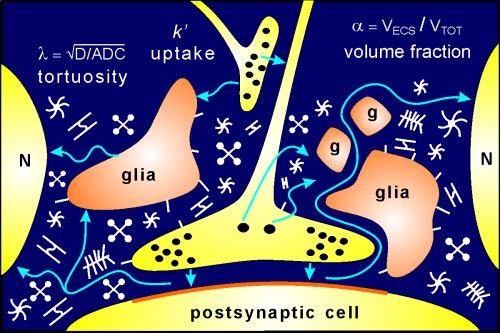
Although synaptic transmission is an important means of communication between neurons, neurons also communicate among themselves and with glia by extrasynaptic “volume” transmission, which is mediated by diffusion in the extracellular space (ECS). The ECS of the central nervous system (CNS) is the microenvironment of neurons and glial cells. The composition and size of the ECS change dynamically during neuronal activity as well as during pathological states. Following their release, a number of neuroactive substances, including ions, mediators, metabolites and neurotransmitters, diffuse via the ECS to targets distant from their release sites. Glial cells affect the composition and volume of the ECS and therefore also extracellular diffusion, particularly during development, aging and pathological states such as ischemia, injury, X-irradiation, gliosis, demyelination and often in grafted tissue. Recent studies also indicate that diffusion in the ECS is affected by ECS volume inhomogeneities, which are the result of a more compacted space in certain regions, e.g., in the vicinity of oligodendrocytes. Besides glial cells, the extracellular matrix also changes ECS geometry and forms diffusion barriers, which may also result in diffusion anisotropy. Diffusion therefore plays an important role in extrasynaptic transmission, for example in functions such as vigilance, sleep, depression, chronic pain, LTP, LTD, memory formation and other plastic changes in the CNS. ECS diffusion parameters affect neuron-glia communication, ionic homeostasis and the movement and/or accumulation of neuroactive substances in the brain.
 |
Schematic of CNS architecture, composed of neurons (N), glial cells (glia), neuronal and glial processes (g), molecules of the extracellular matrix and intercellular channels between the cells. This architecture slows down the movement (diffusion) of substances in the brain, which is critically dependent on the ECS diffusion parameters volume fraction (a), tortuosity (l) and nonspecific uptake (k’). |